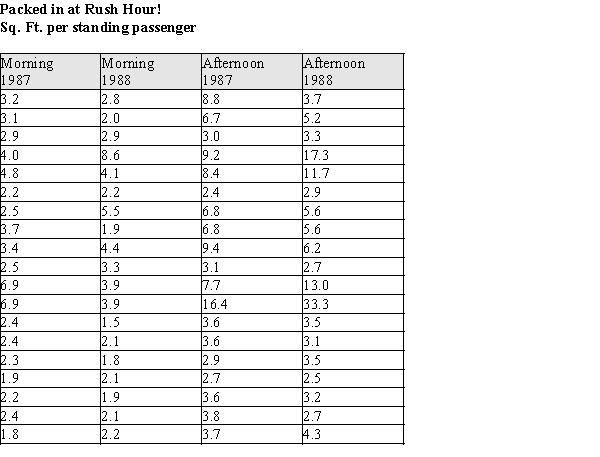Exhibit 3-2
In 1990 the New York Times reported the average number of square feet per standing passenger in 1987 and 1988 for 19 subway stops. Although the sampling method was not reported, we will presume that these data represent a random sample of days during the morning and evening rush hours. The NYC Transit Authority managers attempted to improve the space problem on subway cars (more space is better--trust us!) by adding cars to trains during the rush hours. They gathered the 1988 data to check on their efforts after one year. The data are in the table below. 
-Refer to Exhibit 3-2.
The MTA guidelines in 1987 specified a minimum of 3 square feet per standing passenger. The engineers would like to report standardized measures (z-scores) of this target value. That is, for each year and time of day, they will report how far away the target value of 3 feet is relative to the different distributions.
(a)Consider the original passenger space data for the morning rush in 1987, used in Exhibit 3-2. What are the mean and standard deviation for the sample?  =
=
s =
(b)How many standard deviations above/below the mean is the target value of 3 feet for the distribution in part (a)?
Correct Answer:
Verified
View Answer
Unlock this answer now
Get Access to more Verified Answers free of charge
Q4: The accompanying data are consistent with summary
Q5: Exhibit 3-2
In 1990 the New York
Q7: The questions below refer to decisions made
Q8: Costs per serving (in cents) for 16
Q10: The dot plot below shows the annual
Q10: The interquartile range is resistant to the
Q12: A common topic of study among biologists
Q13: The table below summarizes the number of
Q14: Suppose that the distribution of weekly water
Q18: The mean is the middle value of
Unlock this Answer For Free Now!
View this answer and more for free by performing one of the following actions

Scan the QR code to install the App and get 2 free unlocks

Unlock quizzes for free by uploading documents